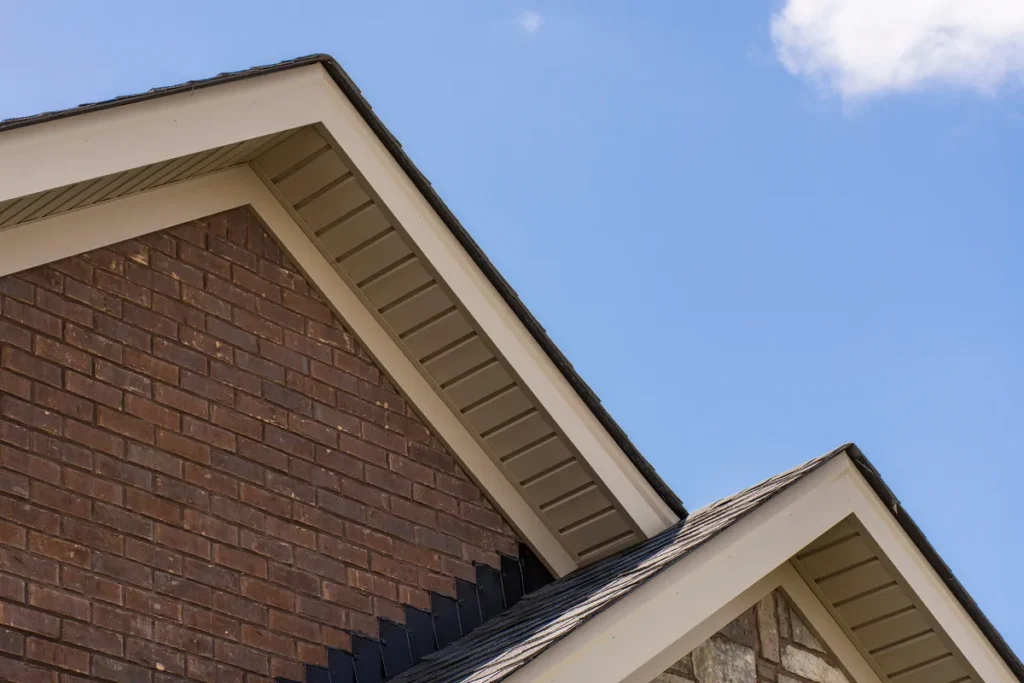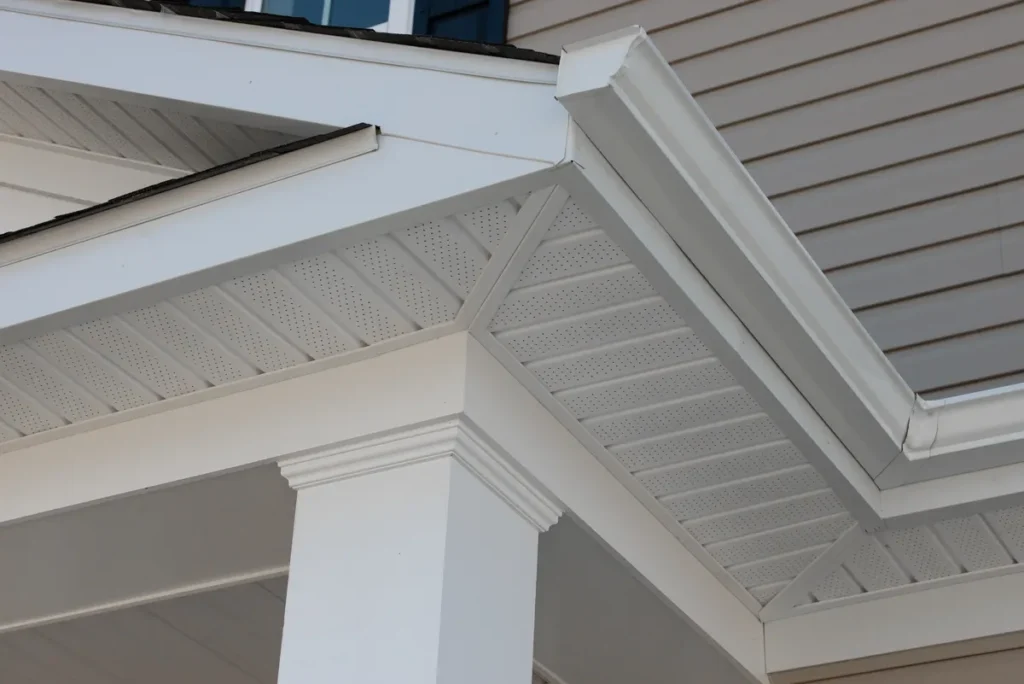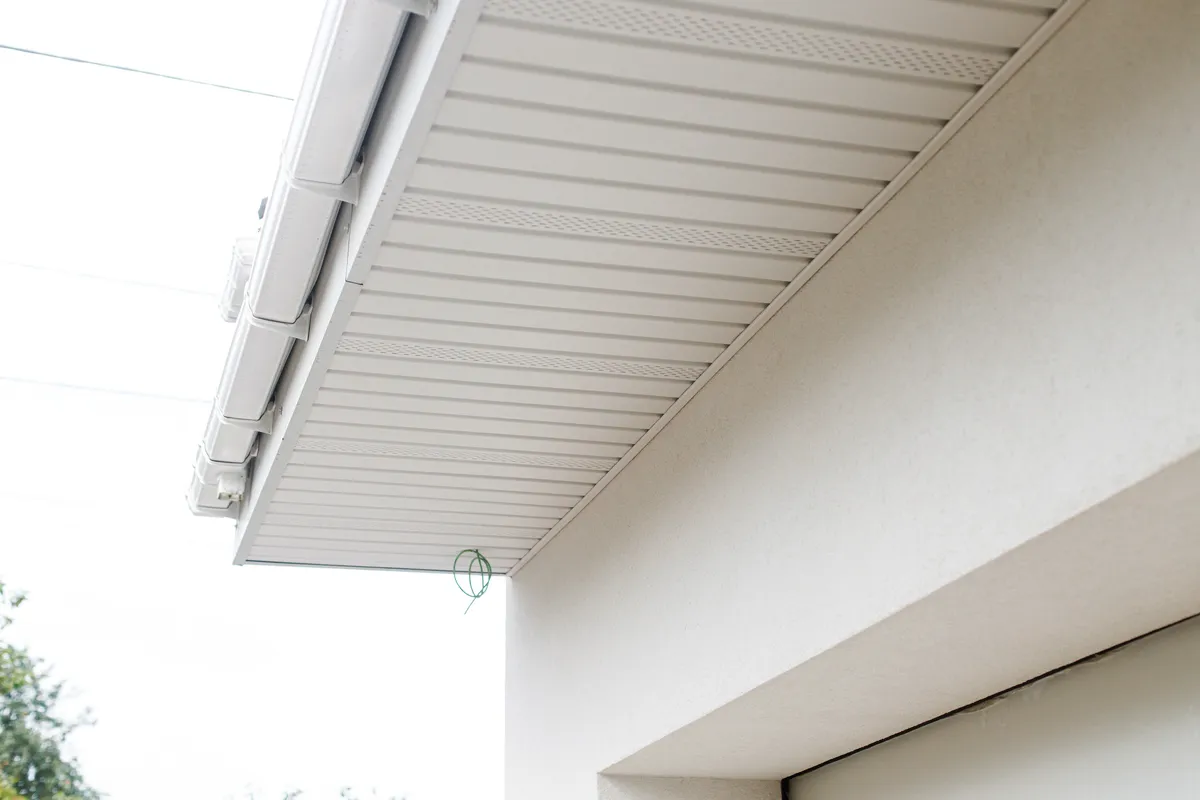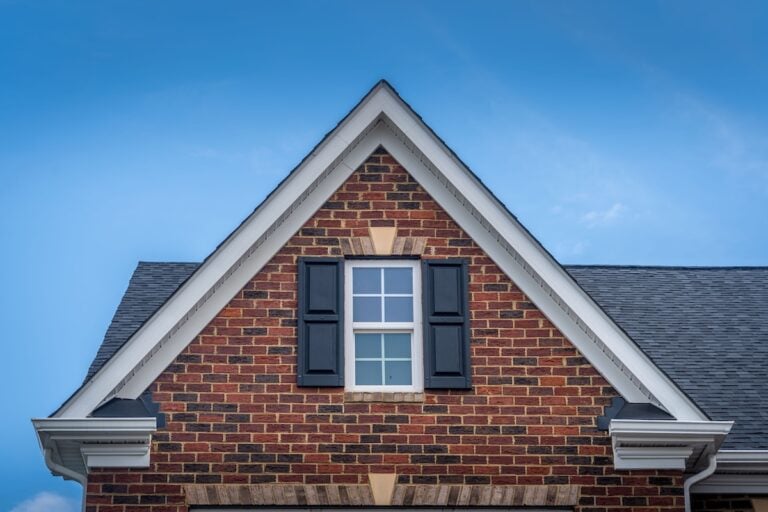If you’ve recently embarked on a home improvement project or are just curious about the various components of your home, you might have come across the term “soffit.” But what is a soffit, and why is it so important for your roofing system?
Our blog is designed to demystify the soffit, explaining:
- Its functions
- Types
- Materials
- Maintenance tips
By the end, you’ll have a thorough understanding of this essential yet often overlooked part of your home.
What is a Soffit?

In architecture, a soffit refers to the material that covers the underside of a roof’s eaves. In simpler terms, it’s the visible part of the eaves when you look up from the ground. The soffit extends from the exterior wall to the edge of the roof, closing the space beneath the roof overhang.
Why is the Soffit Important?
The soffit plays several critical roles in your home’s overall function and aesthetic:
- Ventilation: The soffit allows air to circulate in the attic, which helps regulate temperature and prevent moisture buildup.
- Protection: It protects the rafters from the elements, thereby extending their lifespan.
- Aesthetics: A well-maintained soffit contributes to the home’s curb appeal, providing a finished look to the roof’s edge.
The 3 Functions of a Soffit
The soffit does a variety of different tasks for your home, including:
1) Ventilation
One of the soffit’s most important functions is ventilation. Proper airflow in the attic is crucial for maintaining a balanced temperature and preventing moisture-related issues like mold and mildew. Vented soffits allow fresh air to flow into the attic while pushing out hot, moist air through roof vents. This ventilation helps:
- Reduce Energy Costs: By maintaining a cooler attic, your HVAC system doesn’t have to work as hard, leading to lower energy bills.
- Prevent Ice Dams: In colder climates, proper ventilation prevents the formation of ice dams, which can cause significant damage to the roof and gutters.
2) Protection
The soffit acts as a barrier between the outside elements and the rafters of your roof. Without a soffit, rain, snow, and pests could easily enter your home through the exposed eaves, leading to potential structural damage. The soffit helps:
- Protect Against Moisture: By shielding rafters from rain and snow, the soffit helps prevent wood rot and other moisture-related damage.
- Keep Pests Out: A properly installed soffit acts as a barrier against pests like birds, squirrels, and insects that may try to make nests in your attic.
3) Aesthetics
While functional aspects are crucial, the soffit also significantly impacts the home’s exterior appearance. A well-designed and maintained soffit can enhance the overall look of your home, giving it a polished and complete appearance. It can:
- Enhance Curb Appeal: A clean, well-painted soffit can improve the look of your home, making it more attractive to potential buyers.
- Hide Unsightly Rafters: The soffit provides a smooth, finished surface, hiding the structural elements of the roof.
Types of Soffits

There are several types of soffits based on their design and the material used. Understanding these options can help you make an informed decision when installing or replacing soffits in your home.
Vented Soffit
A vented soffit has small holes or perforations that allow air to flow into the attic. This type is ideal for homes that require enhanced ventilation to maintain attic temperature and moisture levels.
✅ Pros:
- Improves attic ventilation.
- Helps reduce energy costs.
❌ Cons:
- May be susceptible to insect infiltration if not properly screened.
Non-Vented Soffit
A non-vented soffit is a solid panel with no perforations. While it doesn’t provide ventilation, it can be a good option for areas where ventilation isn’t as crucial or where alternative ventilation systems are in place.
✅ Pros:
- Better at keeping pests out.
- Easier to clean and maintain.
❌ Cons:
- Doesn’t contribute to attic ventilation.
Wood Soffit
Wood soffits are traditional and offer a classic, natural look. They can be painted or stained to match the home’s exterior.
✅ Pros:
- Aesthetically pleasing.
- Can be customized with paint or stain.
❌ Cons:
- Requires regular maintenance to prevent rot and insect infestation.
- Susceptible to moisture damage.
Aluminum Soffit
Aluminum soffits are popular due to their durability and low maintenance. They are resistant to rust and can be painted in various colors.
✅ Pros:
- Durable and long-lasting.
- Low maintenance.
❌ Cons:
- Can be dented or scratched.
- Limited color options without painting.
Vinyl Soffit
Vinyl soffits are affordable, durable, and available in various colors and styles. They are resistant to moisture and pests.
✅ Pros:
- Cost-effective.
- Low maintenance.
❌ Cons:
- Can become brittle over time.
- Limited heat resistance.
Fiber Cement Soffit
Fiber cement soffits are robust and resistant to fire, moisture, and pests. They offer the appearance of wood without the associated maintenance.
✅ Pros:
- Highly durable and long-lasting.
- Resistant to fire, moisture, and pests.
❌ Cons:
- More expensive than other materials.
- Requires professional installation.
How to Maintain Your Soffit

Proper maintenance of your soffit is essential to ensure its longevity and functionality. Here are some tips to keep your soffit in top condition:
- Regular Inspections: Conduct regular inspections to check for any signs of damage, such as cracks, holes, or insect infestations. Early detection can prevent minor issues from becoming major problems.
- Cleaning: Clean your soffit periodically to remove dirt, debris, and cobwebs. Use a hose with a spray nozzle to clean vented soffits, ensuring that water doesn’t enter the attic.
- Painting or Staining: If you have wood soffits, reapply paint or stain every few years to protect the wood from moisture and UV damage. Make sure to use a high-quality, exterior-grade paint or stain.
- Repairing Damage: Address any damage promptly to prevent further deterioration. Replace damaged sections of the soffit and ensure proper sealing around the edges to keep out moisture and pests.
Common Problems with Soffits
Despite their importance, soffits can encounter several issues over time. Being aware of these problems can help you address them promptly and effectively.
Moisture Damage
Moisture can seep into the soffit, causing wood to rot or metal to corrode. This issue is more common in areas with heavy rainfall or high humidity.
Solution:
- Ensure proper ventilation to reduce moisture buildup.
- Use moisture-resistant materials like vinyl or fiber cement.
Insect Infestation
Insects like termites and carpenter ants can damage wood soffits, while wasps and bees may build nests in vented soffits.
Solution:
- Regularly inspect and treat wood soffits for insect infestations.
- Install insect screens on vented soffits.
Poor Ventilation
If your soffit isn’t providing adequate ventilation, it can lead to moisture buildup in the attic, causing mold and mildew growth.
Solution:
- Ensure your soffit has adequate venting.
- Consider using a combination of ridge vents and soffit vents for optimal airflow.
Physical Damage
Soffits can suffer physical damage from extreme weather, falling branches, or impact. Dents, cracks, and holes can compromise their functionality and appearance.
Solution:
- Regularly inspect for and repair any physical damage.
- Use durable materials like aluminum or fiber cement to minimize damage.
Installing a New Soffit
If your current soffit is beyond repair or if you’re building a new home, installing a new soffit is a crucial step. While it’s often best to hire a professional, here’s a general overview of the installation process:
Materials and Tools Needed
- Measuring tape
- Ladder
- Saw (for cutting soffit panels)
- Hammer or nail gun
- Nails or screws
- Caulking gun
- Ventilation material (for vented soffits)
- Paint or stain (for wood soffits)
Steps to Install a New Soffit
- Measure and Cut: Measure the length and width of the eaves. Cut the soffit panels to the appropriate size using a saw.
- Install Ventilation (if applicable): If you’re installing a vented soffit, attach the ventilation material to the soffit panels.
- Attach the Panels: Starting from one end, attach the soffit panels to the underside of the eaves using nails or screws. Ensure each panel is securely fastened and fits snugly against the adjacent panels.
- Seal the Edges: Use a caulking gun to seal the edges of the soffit panels to prevent moisture and pests from entering.
- Paint or Stain (if applicable): If you’re using wood soffits, apply paint or stain to protect the wood and enhance its appearance.
Your Roof Soffit Experts
The soffit is a vital component of your home’s roofing system, contributing to ventilation, protection, and aesthetics. Whether you’re installing a new soffit or maintaining an existing one, understanding its functions and types can help you make informed decisions. Proper care and regular inspections will ensure your soffit remains in excellent condition, enhancing your home’s overall functionality and curb appeal.
Ready to upgrade your home’s exterior with a new soffit?
Contact Palladium Roofing today to learn more about our expert installation services and how we can help you achieve a beautiful, well-protected home.





